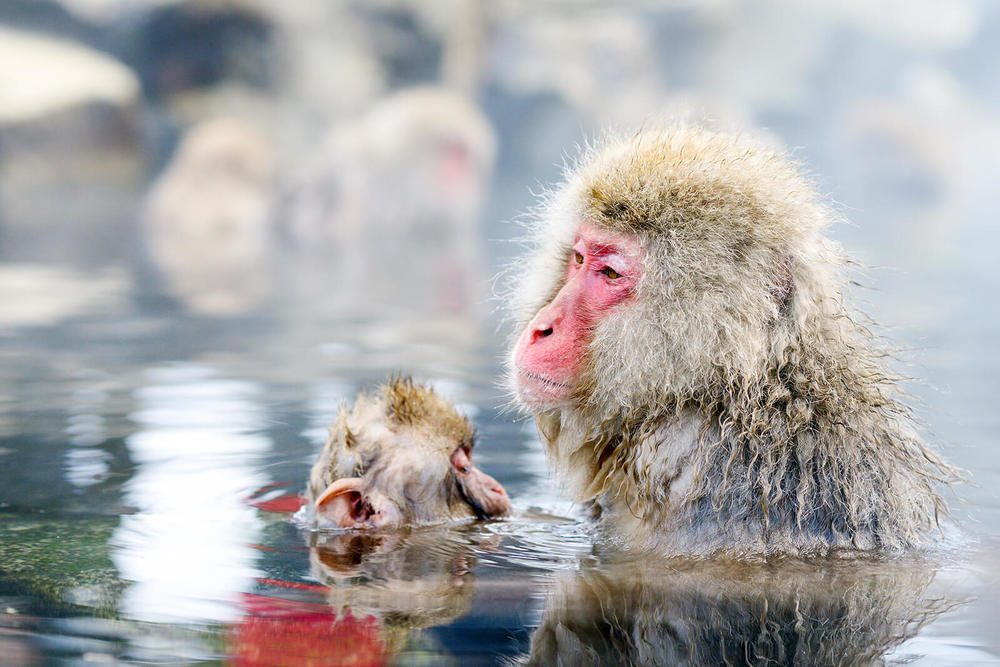The Jigokudani Wild Monkey Park
The only place in the world where you can see wild monkeys soaking in hot spring baths
Update:2020/06/29

The serene faces of snow-covered monkeys soaking in a hot spring bath have become an international sensation. First introduced to the world by US magazine “Life,” the monkeys achieved stardom, later becoming unofficial mascots of the 1998 Nagano Winter Olympics and starring in nature documentaries produced by the BBC. The bubbling hot springs and rugged terrain of Jigokudani create a fascinating backdrop to this natural wonder: the only place in the world where you can see wild monkeys soaking in hot spring baths.
The Japanese Macaques, affectionately called snow monkeys, go about their daily routines without a care for the paparazzi around them. Youngsters splash around the hot spring while mothers tend to their babies and the alpha male watches over the troupe. Their fascinating social structure can be observed up close, not from behind a fence but from right in their midst.
About the Park
The Jigokudani Wild Monkey Park was established in 1964 to create a space where the social structure of Japanese Macaques could be studied. Some say that the park was built after locals noticed the monkeys climbing into the hot spring of a nearby ryokan. No other nonhuman primate is known to live in such cold, snowy climates as the Japanese macaque, and soaking in the hot springs seems to be one way for them to endure the frigid weather.
Jigokudani’s resident troupe is made up of over 200 monkeys that call the mountains around the valley their home. They visit the park during the day to bathe in the springs and eat food provided by the staff of the park. The monkeys are given enough food to encourage their visits, but not so much to make them dependent on humans.
The park is located at the end of a 30 minute walk through a picturesque cedar forest from Kanbayashi, a convenient 45-minute bus ride from Nagano Station.
Seeing the Monkeys Year-round
Despite being called “snow monkeys,” the Japanese macaques of Jigokudani are a sight to see year-round. In spring, adorable baby monkeys frolic all over the park, splashing in the water, climbing rocks, and running through visitors’ legs. In summer, the monkeys shed their thick winter coats, laze in the shade, and play in the river. In autumn, the park is decorated in beautiful shades of red, yellow, and orange. And while they may not always be soaking in the springs, you can always enjoy the experience of being in the midst of these majestic, wild monkeys.
What to do After Seeing the Snow Monkeys
Stay at a Hot Spring Inn in Yudanaka/Shibu Onsen

The Jigokudani Wild Monkey Park is located outside of the hot spring towns of Yamanouchi. After seeing the monkeys enjoy the warmth of a hot spring bath, head back to Yudanaka-Shibu Onsen and soak in the rejuvenating waters of one of its many bathhouses. If you stay in one of the hotels there, you can enjoy all nine public bathhouses around town while walking through cobblestone streets in yukata robes and geta sandles. The area has been a hot spring resort for hundreds of years and is filled with beautiful, multi-story wooden ryokan. One of them is even considered an inspiration for the bathhouse in Ghibli’s “Spirited Away.”
Ski or Hike in the Highlands of Shiga Kogen

Above Jigokudani and Yamanouchi are the highlands of Shiga Kogen, which offer world-class skiing during winter and abundant trekking and hiking trails in summer. The views from the top of the mountain can’t be beat!
Visit Nearby Historical Sites
Along the Nagano Dentetsu line, Obuse and Nagano City offer more nearby sightseeing. Obuse’s quaint, cobbled streets are filled with cafes and restaurants serving food made with locally-grown produce and chestnuts. The Hokusaikan museum is a popular stop for Japanese-art lovers as well. Nagano City is home to venerable Zenkoji temple, as well as the spiritual forests of Togakushi and the samurai town of Matsushiro.
Access to the Jigokudani Wild Monkey Park
The park is located in the Jigokudani Valley behind the town of Yamanouchi. It accessible by car and public transportation, but it at the end of 30-minute-long walking trail. The trail can be quite slippery during winter, so we recommend bringing winter boots and renting crampons and/or a walking stick at the trailhead.
The Snow Monkey 2-Day Pass
Those traveling by public transportation will want to purchase the Snow Monkey 2-Day Pass, which covers unlimited transportation for 2 days on the Nagaden train and buses between Nagano and Jigokudani as well as entrance to the park.
The pass can be purchased at the ticket window at Nagaden Nagano Station (Nagano Station B1F). It costs 3,600 yen for adults or 1,800 yen for children.
By Public Transportation
From Nagano City
From Nagano City, there are two ways to reach the park. The easiest way is to take the Shigakogen line bus from the east exit of Nagano Station (45 min., 1,400 yen). From the Snow Monkey Park bus stop, you walk 35 minutes to the park. You can also take the Nagano Dentetsu line train (B1F of Nagano Station) to Yudanaka Station (45 min., 1,290 yen), then take the local bus from there to the Snow Monkey Park stop (8 min., 310 yen).
By Car
The parking lot for Jigokudani is about 22 minutes (15km) away from the Shinshu Nakano IC exit of the Joshin'etsu Expressway. The lot is located next to the Enza Cafe (Tel: 0629-38-1736). During spring, summer and autumn, another closer parking lot is available (Tel: 0269-33-5733). Parking at this lot costs 500 yen.


















